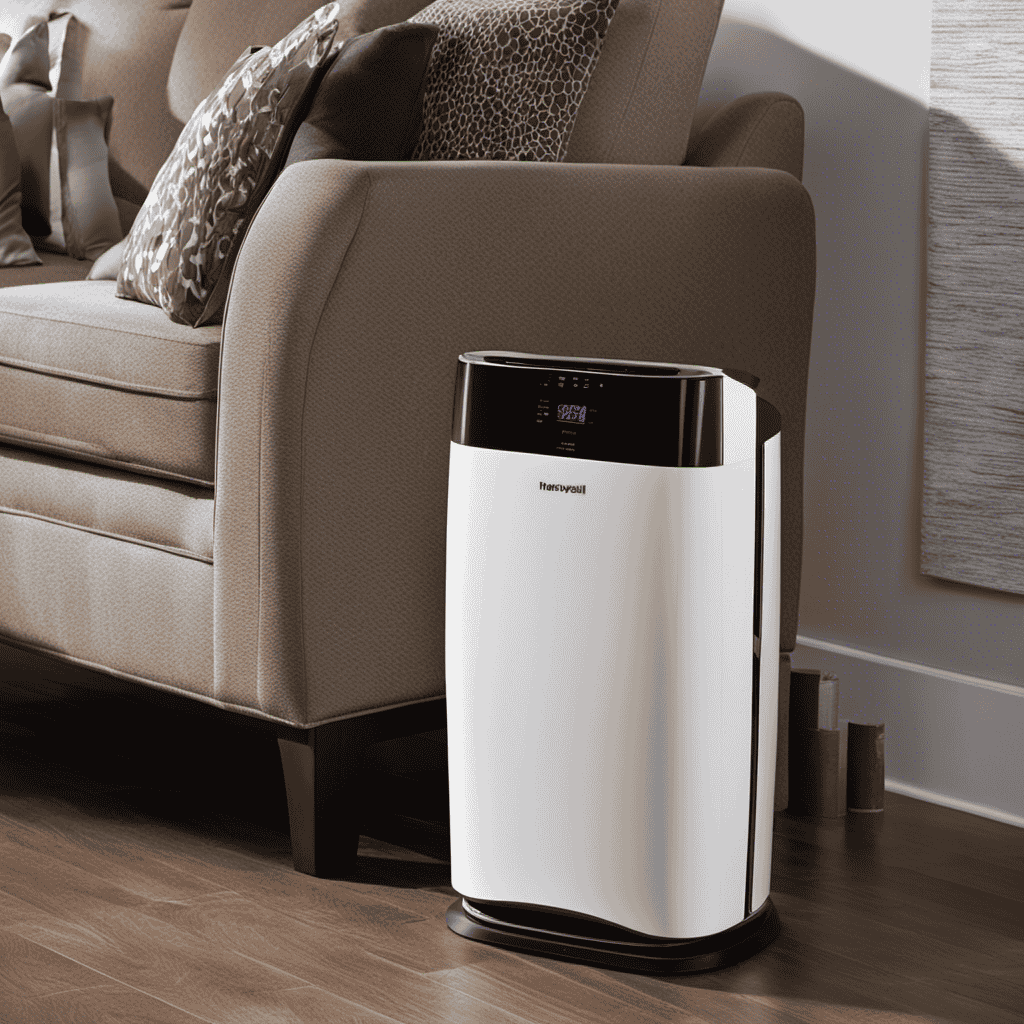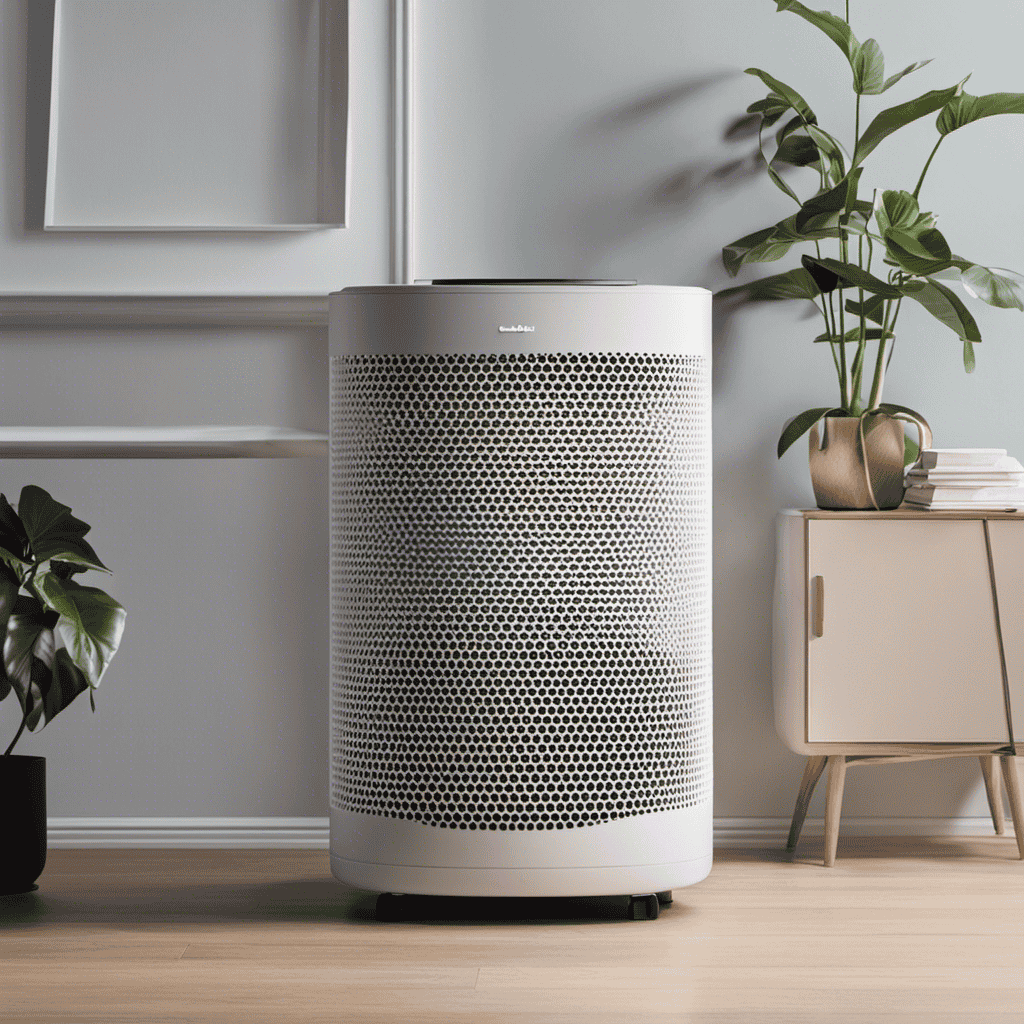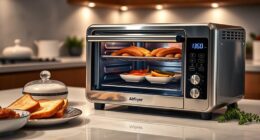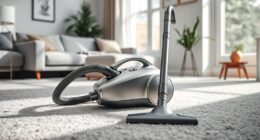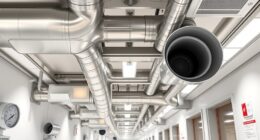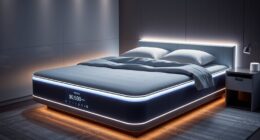As an individual who prioritizes the importance of breathing clean and fresh air, I understand the significance of selecting the appropriate air purifier for your area. The task of picking out the correct size and capacity can appear overwhelming, however, worry not – I am here to assist you in navigating this process.
In this article, we will dive into the technical aspects of measuring for an air purifier. From understanding air quality factors to evaluating room dimensions, we will leave no stone unturned.
So, let’s roll up our sleeves and get started on the path to cleaner air.
Key Takeaways
- Particle Counting and Gas Analysis: Utilize particle counters and gas analyzers as measuring tools to accurately measure the air quality and identify pollutants in the air.
- Consider Room Size and Clean Air Delivery Rate (CADR): Choose the right size air purifier based on the square footage of the room and the recommended CADR for effective air cleaning.
- Regular Maintenance and Replacement: Regularly inspect and clean air ducts and HVAC systems, replace air filters, and install air purifiers with smart sensors to ensure optimal performance and prevent pollutant recirculation.
- Evaluate Indoor Air Quality Factors: Consider factors like humidity levels, allergens, unpleasant odors, particulate matter, VOCs, and filtration technology when evaluating indoor air quality and selecting the right air purifier.
Understanding Air Quality
To understand air quality, you’ll need to consider factors such as pollutants, allergens, and humidity levels. Understanding air pollutants is crucial for improving indoor air quality. Air pollutants can come from various sources, including outdoor pollution, tobacco smoke, and household products. These pollutants can have harmful effects on our health, causing respiratory problems, allergies, and even long-term diseases.
Improving indoor air quality is essential to create a healthier living environment. This can be achieved by reducing the sources of pollutants, increasing ventilation, and using air purifiers. Air purifiers are devices designed to remove airborne contaminants from the air, such as dust, pollen, pet dander, and mold spores. They can play a significant role in reducing air pollutants and improving indoor air quality.
Now that we understand the importance of air quality and pollutants, let’s move on to the next step: choosing the right air purifier size.
Choosing the Right Air Purifier Size
When choosing the right size for your air purifier, make sure to consider the square footage of the room you want to purify. A properly sized air purifier is crucial to effectively clean the air in your space. To help you determine the appropriate size, consider the following room layout and air purifier features:
| Room Size (Square Feet) | Air Purifier CADR (Clean Air Delivery Rate) | Recommended Air Purifier Size |
|---|---|---|
| Up to 300 | 100-150 | Small |
| 300-500 | 150-200 | Medium |
| 500-800 | 200-300 | Large |
| 800-1000 | 300-400 | Extra Large |
| 1000+ | 400+ | Multiple Large |
Determining the Area to Be Purified
When it comes to choosing the right air purifier for a room, there are a few important factors to consider.
First, room size plays a crucial role in determining the effectiveness of an air purifier.
Secondly, calculating the air volume of the room helps in selecting an appropriate purifier with the right capacity.
Room Size Considerations
The first thing you need to consider is the size of your room when choosing an air purifier. It is crucial to understand the dimensions of your room to ensure that the air purifier can effectively clean the air within it.
The room layout also plays a significant role in determining the placement of the air purifier. It is essential to place the purifier in an area where it can intake the maximum amount of air and circulate it efficiently. Avoid placing it near obstructions such as furniture or walls that may hinder the airflow.
Additionally, ensure that the purifier is positioned at an optimal height to capture both airborne particles and gases effectively. Consider the recommendations provided by the manufacturer regarding the suitable room size for the air purifier to achieve the best results.
Calculating Air Volume
To accurately calculate the air volume in your room, you’ll need to measure the length, width, and height of the space. This step is crucial because understanding the air volume is essential in determining the appropriate air purifier size and capacity needed for your room.
The importance of air flow cannot be overstated when it comes to maintaining good indoor air quality. Adequate air flow ensures that pollutants and allergens are effectively captured and removed from the room.
Additionally, understanding filtration efficiency is crucial in selecting the right air purifier. Look for models with high-efficiency particulate air (HEPA) filters, as they are proven to remove up to 99.97% of particles as small as 0.3 microns.
Identifying Pollutant Sources
Identifying where pollutants originate from is crucial for improving indoor air quality. By understanding the sources of indoor air pollution, we can take effective measures to reduce its impact on our health.
Here are some key sources to consider:
-
Indoor sources:
-
Combustion appliances like stoves and fireplaces
-
Volatile organic compounds (VOCs) emitted from cleaning products, paints, and furniture
-
Outdoor sources:
-
Vehicle exhaust and industrial emissions
-
Pollen and other allergens brought in from outside
By identifying these pollutant types and their sources, we can implement strategies to minimize their presence indoors. This may involve proper ventilation, air purification systems, and using environmentally friendly products. Such measures will help create a healthier indoor environment for everyone.
Now, let’s move on to measuring the room dimensions to ensure effective air purification.
Measuring the Room Dimensions
Accurate measurements are crucial when it comes to choosing the right air purifier for your space. Common measuring mistakes can lead to incorrect purifier selection and a compromised air quality.
In this discussion, we will delve into the importance of accurate measurements. We will also explore some common measuring mistakes to avoid. Finally, we will provide guidance on how to choose the right purifier for your specific needs.
Importance of Accurate Measurements
Measuring correctly is crucial when it comes to selecting the right air purifier. Understanding measurement techniques and ensuring accurate measurements have several benefits:
-
Properly sized air purifier: By measuring the room dimensions accurately, you can determine the appropriate size of the air purifier needed to effectively clean the air in your space.
-
Optimal performance: Accurate measurements help in selecting an air purifier that can efficiently filter the air in your room, removing pollutants such as dust, allergens, and odors.
-
Improved air quality: With accurate measurements, you can ensure that the air purifier is powerful enough to purify the entire room, resulting in cleaner and healthier air for you and your family.
-
Energy efficiency: By selecting the right-sized air purifier, you can avoid overworking the device, leading to energy savings and lower utility bills.
Common Measuring Mistakes
In order to ensure accurate measurements for air purifiers, it is important to be aware of common measuring mistakes that can occur. These mistakes can lead to incorrect readings and ultimately affect the efficiency of the air purifier.
One common mistake is not using the appropriate measuring technique. Different pollutants require different techniques to measure accurately. For example, particle counters are commonly used to measure particulate matter, while gas analyzers are used to measure gases and chemicals in the air.
Another mistake is not using the proper measuring tools. Accurate measurements rely on using the right equipment. Some common measuring tools for air purifiers include anemometers to measure air velocity, hygrometers to measure humidity levels, and photometers to measure light intensity.
By avoiding these common measuring mistakes and utilizing the correct techniques and tools, one can ensure accurate measurements for air purifiers, leading to improved indoor air quality.
| Measuring Technique | Measuring Tools | Common Mistakes |
|---|---|---|
| Particle Counting | Particle counters | Not using appropriate technique |
| Gas Analysis | Gas analyzers | Using incorrect measuring tool |
| Air Velocity | Anemometers | Ignoring proper measuring technique |
| Humidity Measurement | Hygrometers | Neglecting to use the right tool |
| Light Intensity | Photometers | Failing to follow correct technique |
Choosing the Right Purifier
To make sure you choose the right purifier for your needs, it’s important to consider factors such as room size, filtration technology, and noise levels.
When it comes to air purifier features, there are a few key things to keep in mind. First, look for a purifier with a high CADR (Clean Air Delivery Rate) as this indicates its effectiveness in removing pollutants from the air. Additionally, consider the type of filtration technology used.
HEPA filters are the most common and are highly effective at capturing small particles, while activated carbon filters help eliminate odors. Noise levels can also be a determining factor, especially if you plan to use the purifier in a bedroom or office space.
Overall, by carefully evaluating these factors, you can ensure you select a purifier that is both effective and suitable for your specific needs.
Assessing Air Circulation and Ventilation
Assessing air circulation and ventilation is crucial when determining the effectiveness of an air purifier. In order to improve air quality, it is important to understand the current state of air circulation in the space. One way to assess this is by conducting a airflow test using a smoke pencil or anemometer. This will help determine if there are any areas where air is stagnant or not circulating properly. Additionally, evaluating the ventilation system is essential. This can be done by measuring the air exchange rate, which is the number of times the air in a space is replaced per hour. A higher air exchange rate indicates better ventilation. By assessing air circulation and improving ventilation, the overall effectiveness of an air purifier can be maximized.
| Assessment | Method | Importance |
|---|---|---|
| Airflow test | Smoke pencil or anemometer | Determines stagnant areas |
| Ventilation evaluation | Measure air exchange rate | Indicates quality of ventilation |
Table 1: Methods for Assessing Air Circulation and Ventilation.
Identifying Pollutant Sources
In this discussion, I will explore three key points related to indoor pollutants:
-
Common sources: Understanding the common indoor pollutants is crucial in developing effective strategies for improving indoor air quality.
-
Eliminating those sources: By identifying and eliminating pollutant sources, we can significantly reduce the presence of harmful substances in our living spaces.
-
Preventive measures to avoid future contamination: Additionally, implementing preventive measures can help maintain a clean and healthy indoor environment for everyone.
Common Indoor Pollutants
One of the most common indoor pollutants is secondhand smoke. It can infiltrate every corner of a room, filling the air with harmful chemicals and particles. To combat this issue, there are a few key considerations to keep in mind.
First, room layout plays a crucial role in air purification. Placing an air purifier near the source of the smoke, such as an ashtray or smoking area, can help capture the pollutants at the point of emission. Additionally, positioning the purifier in an area with good airflow, such as near a window or doorway, can aid in the circulation of clean air throughout the room.
Second, proper air purifier maintenance is essential for optimal performance. Regularly cleaning or replacing the filters ensures that the purifier continues to effectively capture smoke particles and other pollutants. Additionally, keeping the purifier free from dust and debris helps maintain its efficiency and prolong its lifespan.
Eliminating Pollutant Sources
To effectively eliminate indoor pollutants, it’s important to identify and remove the sources that contribute to poor air quality. One key aspect of this process is ensuring the measuring accuracy of pollutants. Accurate measurement allows us to determine the extent of contamination and devise appropriate strategies for elimination.
By utilizing advanced measurement technologies and techniques, we can accurately identify the sources of pollutants and target them for removal. This includes identifying specific chemicals, particles, or gases that are present in the indoor environment. Once identified, we can take effective measures such as ventilation improvements, source control, or air purifiers to eliminate these pollutants.
By focusing on measuring accuracy and pollutant elimination, we can create cleaner and healthier indoor environments for everyone.
Transitioning into the next section, preventing future contamination requires ongoing monitoring and maintenance.
Preventing Future Contamination
By utilizing advanced technologies, we can ensure ongoing monitoring and maintenance to prevent future contamination. This is essential for creating a healthy and safe indoor environment.
To achieve this, here are some future improvements and maintenance tips to consider:
- Regular inspection and cleaning of air ducts and HVAC systems to prevent the buildup of dust, mold, and other contaminants.
- Installing air purifiers with smart sensors that detect pollutants and adjust purification levels accordingly.
- Regularly replacing air filters to maintain optimal performance and prevent the recirculation of pollutants.
- Implementing air quality monitoring systems that provide real-time data on pollutant levels and enable timely interventions.
By implementing these measures, we can significantly reduce the risk of future contamination and promote better indoor air quality.
Now, let’s delve into evaluating indoor air quality factors to further enhance our understanding and management of this important aspect.
Evaluating Indoor Air Quality Factors
Assess your indoor air quality by considering factors such as humidity levels, the presence of allergens, and any unpleasant odors. Evaluating air pollution and testing air quality are essential in ensuring a healthy and comfortable living environment.
To evaluate air pollution, you can use air quality monitors that measure particulate matter, volatile organic compounds (VOCs), and carbon dioxide levels. These devices provide accurate and real-time data on the air quality in your home.
Additionally, testing for allergens, such as dust mites, pet dander, and pollen, can help identify potential triggers for allergies and respiratory issues. Unpleasant odors can be an indication of mold, mildew, or other contaminants.
Calculating Air Purifier Capacity
Calculating the capacity of an air purifier can help determine its effectiveness in improving indoor air quality. It is important to consider the size of the room or area that needs to be purified, as well as the level of air pollution present.
To calculate the capacity needed, I would recommend following these steps:
-
Determine the square footage of the room or area.
- Measure the length and width of the space.
- Multiply the two measurements to get the square footage.
-
Consider the Clean Air Delivery Rate (CADR) of the air purifier.
- CADR measures the volume of clean air produced by the purifier.
- Look for a CADR that is suitable for the square footage calculated.
When comparing air purifier brands, it is also important to consider the cost. Calculate the cost per square footage to determine the most cost-effective option.
Considering Noise Levels and Energy Consumption
When considering noise levels and energy consumption, you should look for an air purifier that operates quietly and is energy efficient.
Noise reduction is an important factor to consider, especially if you plan to use the air purifier in a bedroom or office. Look for models that have low decibel ratings and features like a sleep mode, which further reduces noise levels during nighttime use.
Additionally, energy efficiency is crucial for reducing electricity costs and environmental impact. Look for air purifiers that are ENERGY STAR certified, as this indicates they meet strict energy efficiency guidelines. These models often have advanced technologies, such as sensor-based operation and programmable timers, that help optimize energy consumption while maintaining effective air purification.
Consulting Experts and Reviews
When considering which air purifier to purchase, it is important to consult experts and read reviews. These valuable resources can provide insight into the performance, features, and overall effectiveness of different air purifier models.
Here are some reasons why consulting experts and reading reviews is crucial:
-
Expert opinions:
-
They have in-depth knowledge about air purifiers and can recommend models that suit your specific needs.
-
They can provide information on the latest technologies and advancements in air purification.
-
Reviews from users:
-
Real-life experiences from users can help you understand the pros and cons of different air purifiers.
-
Detailed reviews can highlight the noise levels, energy consumption, and overall performance of the product.
Frequently Asked Questions
How Often Should I Replace the Filters in My Air Purifier?
I replace the filters in my air purifier every 3 to 6 months to maintain its efficiency. Cleaning the filters regularly and keeping the surrounding area clean can also improve the purifier’s performance.
Are There Any Specific Types of Air Purifiers That Are More Effective at Removing Pet Dander?
Different types of air purifiers for pet dander can be more effective at removing pet allergens. As a pet owner, using an air purifier provides numerous benefits, such as reducing allergies and improving indoor air quality.
Can an Air Purifier Completely Eliminate Odors in a Room?
Yes, air purifiers can effectively eliminate smoke odors in a room. However, there are also natural alternatives available for odor elimination, such as ventilation, activated charcoal, and baking soda.
Is It Necessary to Run the Air Purifier Continuously, or Can I Turn It off When I’m Not in the Room?
I can turn off the air purifier when I’m not in the room. However, for optimal air purifier maintenance and to maximize the benefits of using it in a small space, it is recommended to run it continuously.
Are There Any Potential Health Risks Associated With Using an Air Purifier for Long Periods of Time?
There may be potential health risks associated with using an air purifier for long periods of time. Research suggests that continuous exposure to ozone emitted by some purifiers can lead to respiratory issues and other health problems.
Conclusion
In conclusion, choosing the right air purifier size is crucial for maintaining clean and healthy indoor air. By understanding air quality, measuring room dimensions, assessing ventilation, and evaluating indoor air quality factors, one can accurately calculate the air purifier capacity needed.
Additionally, considering noise levels and energy consumption is important for a comfortable and efficient purifying experience. Consulting experts and reading reviews can provide valuable insights.
So, why compromise on your health when you can ensure fresh air with the right air purifier?

